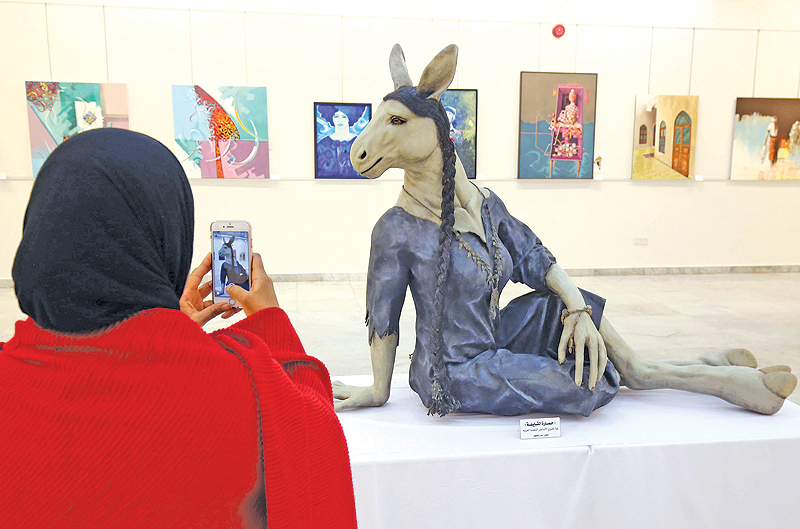
Kuwait's cultural heritage has its share, as in numerous other societies, of mythical folk tales with often frightening central characters that were resorted to in the past by parents to induce the children to comply with parental requests to do certain chores. In the main, parents used these mythical characters, some having human traits, others mostly supernatural, to coax the children to go to sleep at bedtime or to stay home and not go outside to play at certain hours of the day which the parents deemed inappropriate.
Overall these characters were routinely relied on by Kuwaiti adults in the past in spicing up what may be described as spooky campfire tales to attract children's attention to these tales. On this subject, Professor of Anthropology at Kuwait University Dr. Mohammad AlHaddad indicated in an interview that mythical folk tales and mythical boogeymen that deal with the supernatural are very much partandparcel of a nation's culture handed down from one generation to another.
Why did adults in Kuwait's past tell their children stories with mythical characters that were beastly and terrifying? Dr. AlHaddad said it was all done to scare the children into complying to their parents' orders, mainly, not to go outside to play at high noon when the temperature in Kuwait was unbearably sizzling hot and could be a source of danger to children exposed to it. Basically it was the fear of a sunstroke that made the parents tell these awful stories to their offspring to dissuade them from playing outside the house, he said.
The vast majority of the boogeymen in Kuwaiti mythological tales for children were male, the most notorious of them being one known in the Kuwaiti dialect as the "Tantal," a tall black man, of three meters in height, with disheveled hair whose footsteps were audibly heavy. He would roam around in the dead of night, holding a large staff or cane which he would use to strike his victims with. Tantal was sometimes not seen at night because he opted to wander in the night as a ghost, looking to kidnap children. "The mythical character of Tantal has vanished from today's culture, yet the name itself is still used in the Kuwaiti dialect to refer to a man of great height or a woman for that matter," said Dr. AlHaddad.
Another such mythical character in old Kuwait lore is that of AlSeolu, which he said was referred to by the Kuwaiti historian Yousef AlQenaie in his book "Pages from the History of Kuwait." In it, AlSeolu is described as a Nubian slave, tall with elongated teeth who kidnaps children and cannibalizes them. In 1910, a lot of people in Kuwait became terrified of Al-Seolu because a little boy drowned by the seashore and was never found again, leading people to believe that he had been eaten by the AlSeolu, said Dr. Al-Haddad.
Not all mythical characters in Kuwaiti folklore are of evil nature, he said, noting that the character of "Sehaila Um AlKhalajeen" was thought of as a homeless woman who rummaged in the garbage to salvage old rags which she would hastily retailor to fit her physique. The result was often that the clothes were way too big for her and dragged on the ground behind her, making her look unseemly and repugnant.
Another not so evil character is that of Um AlSa'af WaAlleef, who is a grotesque looking woman, totally unkempt, who can fly using a palm frond, said Kuwaiti heritage researcher Hani AlAsousi.
A character who is a hybrid human and animal, having the frightening countenance of an old woman and the feet of a donkey is named "Hemarat AlGayla " (literally meaning a high noon donkey) who parents referred in order to scare the children with when they were ornery, he said. "AlDuaidea" is a mythological character that made a person see a burning cinder that mysteriously changed its location when approached to be picked up, he said. A marine character, called "Bu Darya" was well known by sailors who thought of it as a halfhuman halffish creature that roamed the high seas, shrieking in the middle of the night in the guise of someone drowning. When approached for rescue, the creature would grab the rescuer and drown him unceremoniously, said Al-Asousi. He further said all these myths and folk tales and mythical characters spread around the society at a time when illiteracy and ignorance prevailed. With the advent of modern times and the ubiquity of education these old wives' tales have fully receded and children can now go to sleep without being prodded with the tale of a terrifying ogre. - Shared from KUNA archives
By Sarah Al-Mukhaizeem




